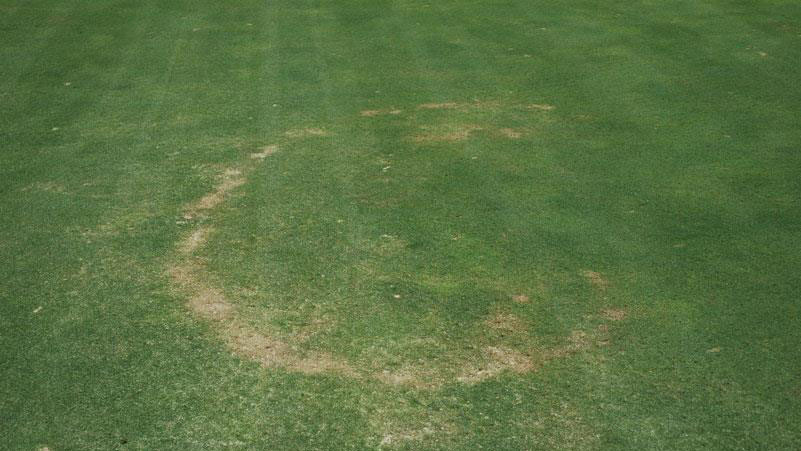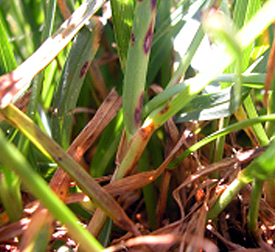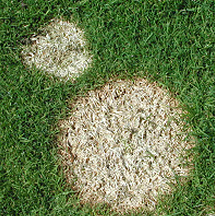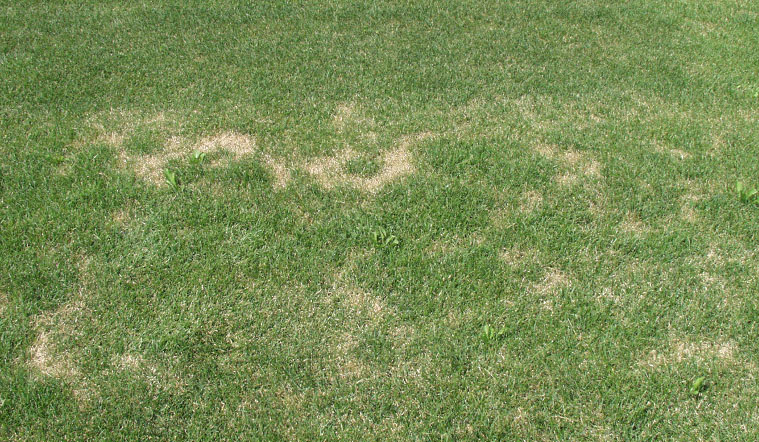Lawn Disease Guide: Causes, Symptoms, and Prevention
At Custom Lawns, we understand how frustrating it can be to see brown patches or thinning turf take over your lawn. Many Cleveland lawns experience fungal diseases caused by Ohio’s humid summers, cool nights, and excess moisture. Many homeowners assume their lawn has a fungus, but quite often the issue is simply lack of water during dry weather. When rainfall is scarce, grass naturally goes dormant and turns brown — this is normal and temporary.
However, if your lawn stays brown even after consistent watering or shows circular spots, patches, or a slimy texture, a fungal lawn disease may be to blame. Below are some of the most common lawn diseases in Northeast Ohio along with causes, signs and symptoms, and how to manage them.
Brown Patch

Causes
Hot, wet days with high humidity and nighttime temps above 65 degrees can favor development of brown patch. Excess moisture on leaf surface from rain, dew, or evening irrigation. Areas with poor circulation or compacted soil.
Signs & Symptoms
- Irregular circular patches
- Patches vary from tan to brown shades
- Outer edge of patch may be darker
- Irregular shaped lesions on leaves
management
Water lawn early in the morning, so leaves dry quickly. Mow regularly at about 3-3.5 inches and keep the mower blades sharp. Annual core aerations will help the compacted soil roots to breathe. For persistent or severe infections, a fungicide can be applied by Custom Lawns. Maintain a fertilization program year-round.
Dollar spot

causes
Dollar spot is one of the most common and persistent turfgrass fungal diseases. It thrives in warm, humid weather especially when grass stays went for long periods while the soil remains dry. This results in slow growth and poor recovery from damage by disease. More severe in low-nitrogen lawns.
signs/symptoms
- Tiny yellow spots on individual grass blades initially leading to entire blade becoming bleached
- As grass dies, the infected areas enlarged, light straw-colored spots 2-3″ in diameter in the lawn
- A fine, cobwebby white mycelium may be visible early in the morning if dew is present
MANAGEMENT
Water lawn deeply but infrequently early in the morning. Avoid frequent, light watering which promotes fungal growth. Get on a regular fertilization program to keep balance of nitrogen, a soil test may be recommended. Aerate annually to improve soil drainage and flow. Custom Lawns can apply a fungicide if necessary.
fairy ring

causes
Fairy rings are caused by certain fungi that feed on decaying organic matter (ex: tree stumps, logs, leaves) buried in the soil.
There are 3 types:
Type 1: Rings of dead grass
Type 2: Rings of dark green,
fast-growing grass
Type 3: Rings of mushrooms without visible turf damage
SIGNS/SYMPTOMS
- Dark green or brown circles (1′-10’+)
- Grass in dark green ring may grow taller
- Rings may turn brown and die
- Mushrooms may grow in the ring
.
MANAGEMENT
Fairy rings in home lawns do not typically kill the lawn and are primarily a cosmetic concern. They often disappear naturally following changes in environmental conditions.
Maintain even soil moisture by watering deeply and regularly, aerate the soil to break of fungal mycelium and improve water/air flow, reduce thatch, and get on a fertilization program. Custom Lawns can apply a fungicide if necessary, but is most effective when applied early in disease development.
Gray Leaf Spot

causes
Gray leaf spot occurs in prolonged hot and humid weather patterns in late summer and fall. The soil may be moist while the grass appears to be wilted from a drought.
signs/symptoms
- Starts as small, dark spots/flecks
- Leaves often quickly wither and die
- Irregular patches to large areas to die
- Overall appearance as drought stress, even though soil moisture is adequate
MANAGEMENT
Manage watering to minimize time leaves are wet. Water in the early morning. Improve air circulation by trimming trees and shrubs to increase airflow and sunlight to infected area. Aerate compacted areas to enhance water drainage. Overseed areas in the fall with gray-leaf spot cultivars like tall fescue or Kentucky Bluegrass. Maintain a balanced fertilization program.
leaf spot/melting out

causes
Cool, wet weather in spring transitioning to warm, humid days. Excessive thatch or poor drainage causing the lawn to hold moisture. Prolonged lead wetness from rain, dew, or late night watering. Dull mower blades can injure the lawn.
signs/symptoms
- Initially small purple or brown spots on leaves and spots enlarge in size
- Center of spots may be a lighter brown
- As it progresses, crown and roots rot leading to thin, dead patches–a phrase known as “melting out”
MANAGEMENT
Raise cutting height. Mow frequently to avoid stressing lawn. Avoid frequent watering and wet turf. Stay on a consistent fertilization program to keep lawn balanced, a soil test may be recommended to ensure proper nitrogen levels. Aerate annually to improve air movement and drainage. Prune nearby shrubs or trees that create shade or humidity. Custom Lawns can apply fungicide when the disease is active or recurring.
powdery mildew

causes
Outbreaks of powdery mildew tend to occur on grass growing in shaded areas during spring to fall when moderate temperatures of 60-70 degrees and high relative humidity occur.
signs/symptoms
- Initially small purple or brown spots on leaves and spots enlarge in size
- Center of spots may be a lighter brown
- As it progresses, crown and roots rot leading to thin, dead patches–a phrase known as “melting out”
MANAGEMENT
Increase sunlight penetration by pruning trees and shrubs shading the area. This will also help reduce humidity to improve air circulation and remove pockets of stagnant air. Adjust watering so area stay drier. Powdery mildew can be managed with preventative fungicide applications, but it will not remove the disease from the lawn if already present.
Pythium Blight

causes
Pythium blight develops when day temps exceed 85 degrees and night temps stay about 65 degrees (July-August). High humidity and poor air circulation trap moisture near the turf. Overwatering and evening irrigation keeps leaves wet overnight and poor draining/compaction creates soggy soil.
signs/symptoms
- Small, dark, greasy looking spots that appear water soaked
- Grass may look slightly matted or slimy, especially in morning dew
- Greasy spots expand rapidly, forming irregular brow or gray patches
- A cottony or gray mold may appear early in the morning when humidity is high
MANAGEMENT
Improve soil drainage with a core aeration. Increase air circulation by trimming surrounding vegetation. Avoid excess watering and only water in the early morning when necessary. A fungicide can help when conditions favor rapid spread.
red thread

causes
Red thread occurs in moderate/wet foliage when there are prolonged periods of wet leaves. Poor quality soil or soil with low phosphorous are prone to the disease. Most common on grass that is under drought stress or low fertility.
signs/symptoms
- Patches appear as a tan, light pink or reddish
- Leaf tips and edges have fine pink or red strains of fungus present
- Size of patches variable (2-12″)
MANAGEMENT
Follow a complete fertilization program. Promote growth by aeration and proper watering. A soil test may be recommended to see if there are nitrogen and/or phosphorus deficiencies. The lawn will begin to recover when environmental conditions are less conducive for disease.
Rust

causes
Rust is favorable in slightly warm, moist conditions along with prolonged leaf wetness for more than 10 hours when temps are between 68-86 degrees. It most commonly occurs mid-summer through Fall on stressed grass from a drought, low nitrogen, low mowing height, or shade.
signs/symptoms
- First sign is yellow flecks on the leaf blades
- The yellow flecks enlarge and release yellow-orange powdering spores that you may notice on your shoes, mowers, and pets. It is not harmful.
- In severe situations, infected grass can thin
MANAGEMENT
The best way to control and prevent rust is to establish a healthy lawn with a good fertilization program. Avoid moisture stress and raise height of cut. Manage the soil with annual aerations to avoid compaction. Fungicide is not commonly used to control the disease if proper lawn practices are being done, but can be considered for a severe rust outbreak.
Slime Mold

causes
Slime mold is most likely to occur on longer cut grass during wet weather. It occurs in moderate to warm temperatures with prolonged wet foliage between late spring to late fall.
signs/symptoms
- Slimy growths on the surface of grass blades that are usually white or purple, but sometimes cream, gray or yellow
- The growths turn black and become brittle within a few days
MANAGEMENT
Slime mold does not cause damage to the lawn, it is only cosmetic. It can be removed by raking or mowing the affected area. If the weather is dry, the mold can be washed off with a hose.
Snow Mold

causes
Snow mold can after from cool, wet winters. It can develop from saturated, unfrozen soil for long periods. No snow is required. It occurs in winter and spring.
signs/symptoms
- Melting snow reveals circular patches of tan to white grass
- The grass often will become matted and appear slimy when wet
- The border of the patches may have a distinct pink to reddish brown color
- Patches may run together to form large, irregular areas
MANAGEMENT
Keep mowing the lawn to prevent long grass going into winter. Rake and remove leaves. Control drifting snow, prevent piles of snow in the lawn. Ensure the lawn is fertilized in the spring to stimulate regrowth. Severely damaged grass may require reseeding.
Summer Patch

causes
Summer patch occurs from warm/extremes in soil moisture (fluctuating wet to dry). It can appear when the soil quality is poor, compacted, or is clay. It usually occurs on sodded lawns with poor site preparation from a weak or limited root system.
signs/symptoms
- Ring-like patches of wilted turf up to 3″ in diameter
- Rings often merge into larger, irregular patches
- Outer edge of circles/patches are brown with green centers
MANAGEMENT
Avoid low mowing and thatch buildup. Aerate the lawn annually to promote root growth and reduce compaction of soil. Water frequently in the early morning to avoid water stress. Continue on a balanced fertilization program.
not sure what's damaging your lawn? Let our Experts help!
Sources:
Ohio State University, Turfgrass Disease Identification Chart. Turf Disease Chart (Expanded Lawn Version, December 2015)
University of Wisconsin–Madison Division of Extension – Wisconsin Horticulture Articles


